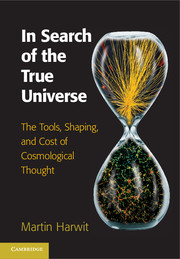Book contents
- Frontmatter
- Contents
- Preface
- Notes on Usage
- 1 The Nineteenth Century's Last Five Years
- Part I The Import of Theoretical Tools
- 2 An Overview
- 3 Conclusions Based on Principles
- 4 Conclusions Based on a Premise
- 5 Conclusions Based on Calculations
- 6 Ask the Right Questions, Accept Limited Answers
- Part II A National Plan Shaping the Universe We Perceive
- Part III The Cost of Discerning the True Universe
- Epilogue
- Appendix: Symbols, Glossary, Units and Their Ranges
- Index
- References
3 - Conclusions Based on Principles
Published online by Cambridge University Press: 05 December 2013
- Frontmatter
- Contents
- Preface
- Notes on Usage
- 1 The Nineteenth Century's Last Five Years
- Part I The Import of Theoretical Tools
- 2 An Overview
- 3 Conclusions Based on Principles
- 4 Conclusions Based on a Premise
- 5 Conclusions Based on Calculations
- 6 Ask the Right Questions, Accept Limited Answers
- Part II A National Plan Shaping the Universe We Perceive
- Part III The Cost of Discerning the True Universe
- Epilogue
- Appendix: Symbols, Glossary, Units and Their Ranges
- Index
- References
Summary
Acting on principle can be rewarding but also risky. What if the principle, against all expectations, turns out to be invalid?
On graduating from the Eidgenössische Polytechnikum in the summer of 1900 with a barely passing grade, the 21-year-old Einstein had no prospects of permanent employment. But as he drifted from one temporary position to another, he was at least free to pursue his passion for physics. Less than five months after receiving his diploma, he submitted his first paper to the leading German journal, the Annalen der Physik. Like all of his papers published in the subsequent three years, it was grounded in thermodynamics.
Thermodynamics is an expression of the conservation of energy as it is converted from one form, such as electrically, mechanically, or chemically stored energy into another. Einstein continued to draw strength from this and other conservation principles for most of the work he would produce. They gave him guidance and assurance as he ventured ever further into uncharted realms.
Rescue of the jobless Einstein came through the father of Marcel Grossmann, Albert's closest friend during their student years at the Polytechnikum. The elder Grossmann was impressed by his son's friend and recommended him to Friedrich Haller, director of the Swiss Patent Office in Bern. When a new position opened there, Einstein at once applied and, in June 1902, won an appointment as patent clerk third-class. He remained immensely grateful to the Grossmanns and, on completing his doctoral work in 1905, dedicated his thesis to his friend.
- Type
- Chapter
- Information
- In Search of the True UniverseThe Tools, Shaping, and Cost of Cosmological Thought, pp. 25 - 54Publisher: Cambridge University PressPrint publication year: 2013



